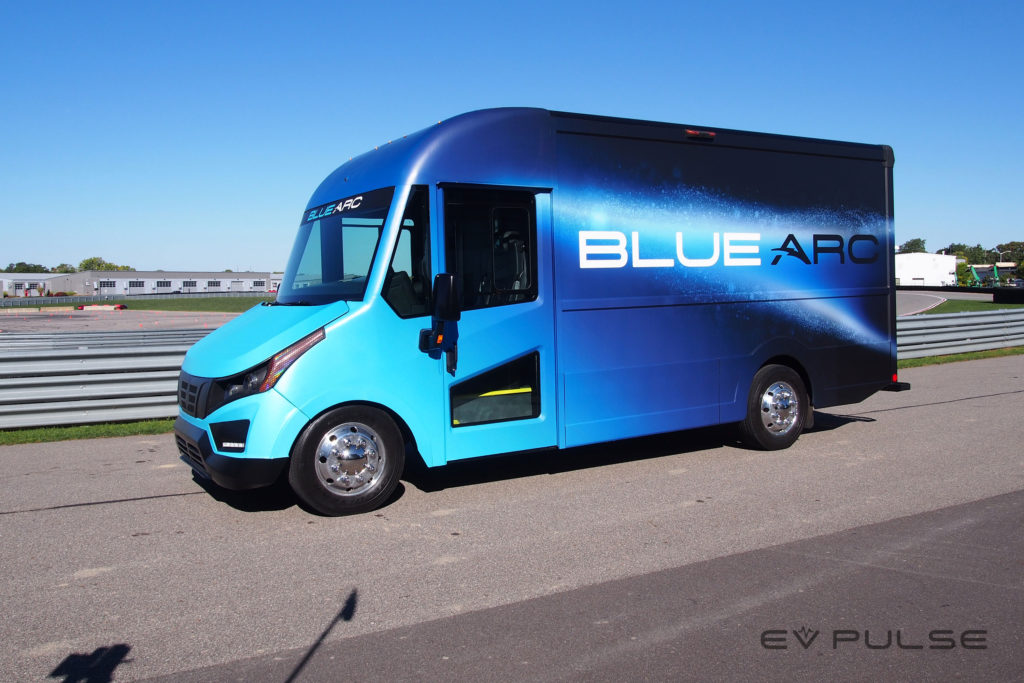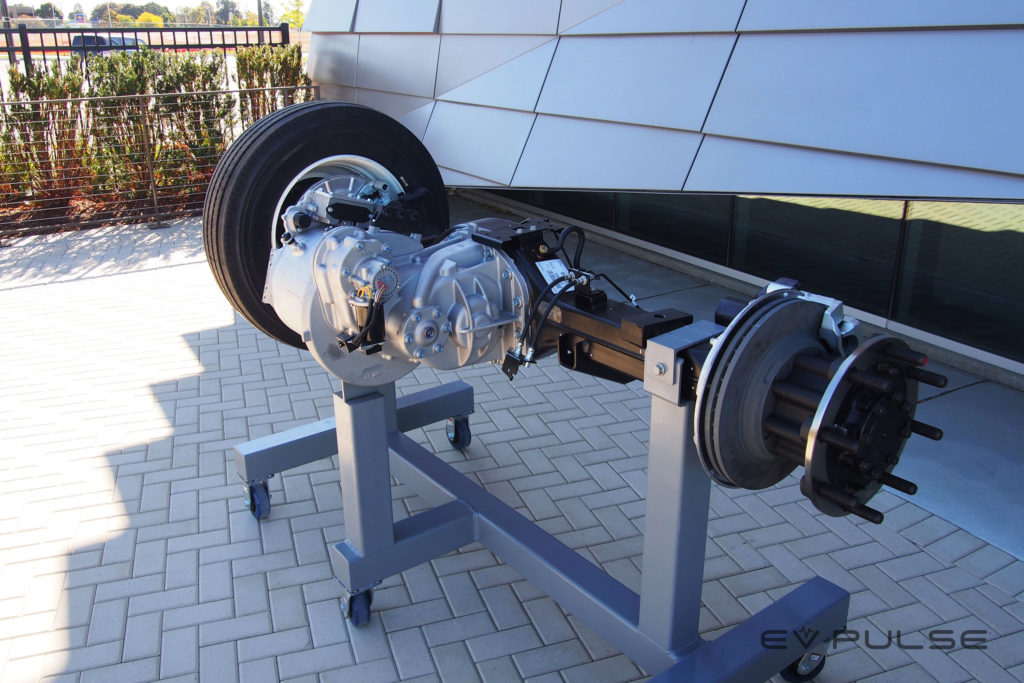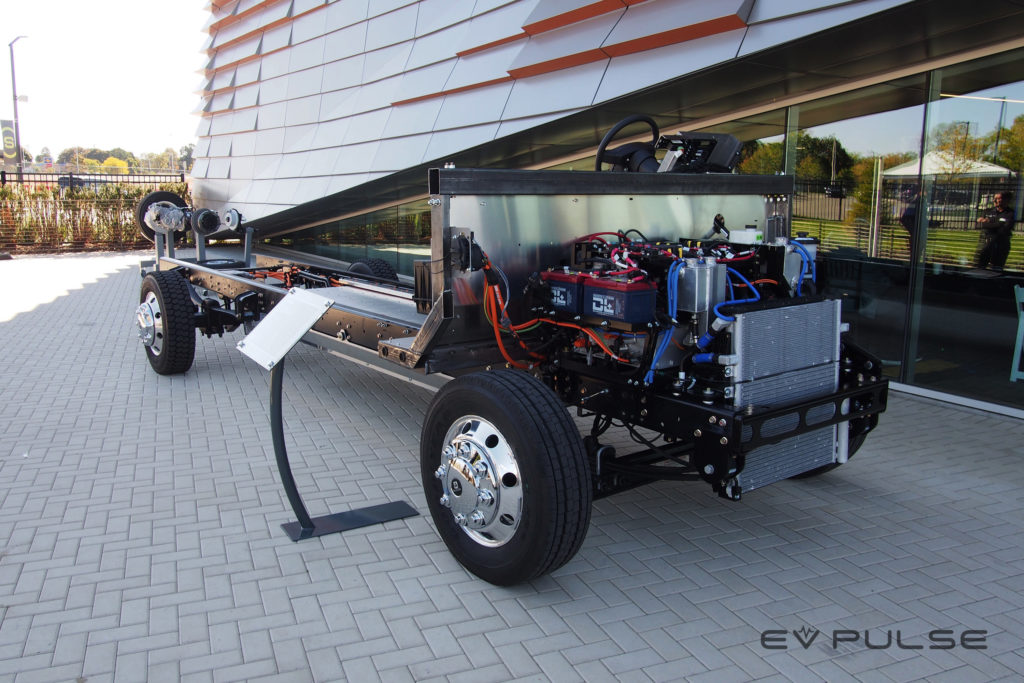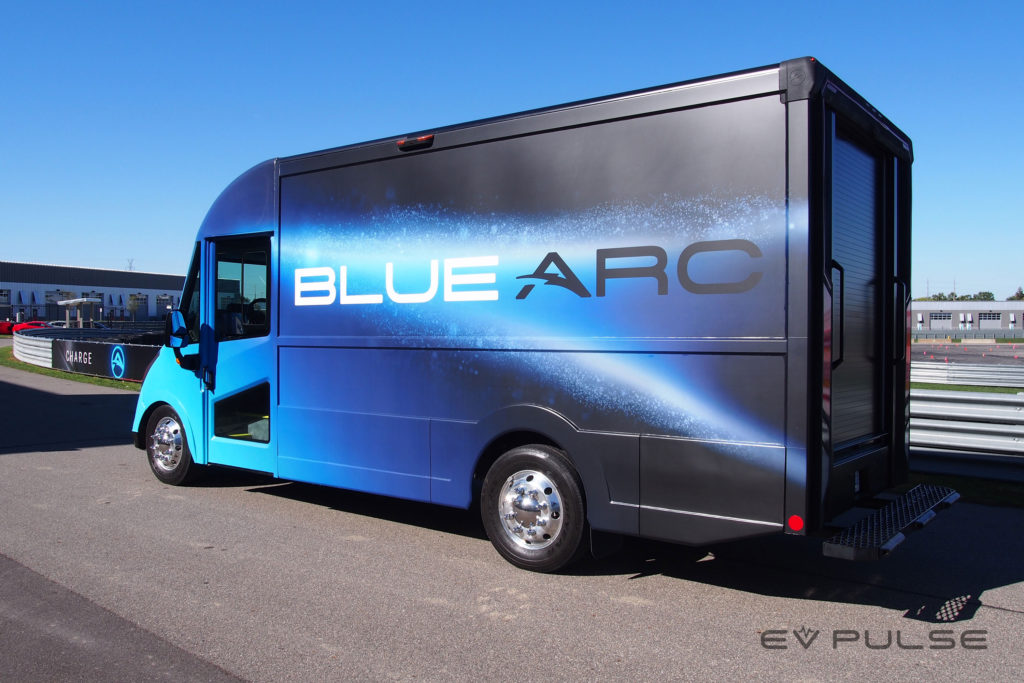The EV revolution is simmering away, but it’s not just passenger cars and pickup trucks that are going electric – commercial vehicles are getting amped up, too. Giving companies a cleaner, safer and all-around better alternative to traditional offerings, the Blue Arc delivery vehicle is a commercial-grade, all-electric walk-in van that will be offered in Class 3, 4 and 5 configurations, unlike the vehicles Ford, GM, Ram and Rivian offer. EV Pulse got an up-close look at this purpose-built vehicle and logistics companies are sure to love it.
Blue Arc is a division of The Shyft Group, which owns a portfolio of commercial vehicle brands including Utilimaster, Spartan and Builtmore. “We’ve been designing and manufacturing specialty vehicle chassis and bodies for 47 years,” said Daryl Adams, the company’s president and CEO. In fact, he noted that some 50% of all parcel delivery vehicles on America’s roadways have been produced by The Shyft Group. This commercial vehicle expertise means they’re uniquely positioned to offer an all-electric van that meets the unique needs of delivery companies like Amazon, FedEx, UPS and others.
The chassis
“A lot of the competitors out there are using existing chassis and they do a retrofit,” said Johann Eloff, vice president of engineering at The Shyft Group. “We’re the only OEM in this class that does the whole vehicle, bumper to bumper, tire to roof.”

Blue Arc designed its all-electric delivery vehicle from the ground up. This clean-sheet approach promises best-in-class ground clearance, ride and handling, and design cleanliness. Key to delivering these attributes is the frame, which is comprised of two massive C-channel sections. These steel components are dead straight and widely spaced, something that makes manufacturing easier and reduces potential failure points compared to frames that narrow or have bends or kicks in them. “It sounds simple, but to execute that wider spacing with all these components, that’s not easy,” said Eloff.
SEE ALSO: The Blue Arc Power Cube is a portable EV charger that can be driven like a remote-controlled car
The vehicle’s rear is supported by a pair of single-leaf springs developed by Hendrickson. This design has fewer moving parts compared to traditional multi-leaf springs and features a variable rate curve, so no rear stabilizer bar is needed. This innovative design should also provide the same ride quality whether the vehicle is loaded to the gills or completely empty.
Unlike other commercial vehicles, the Blue Arc delivery van’s steering is electrohydraulic. This design not only reduces vibration and provides road crown compensation to reduce driver fatigue, but it also allows for Level 2 driver assistance tech like lane-keeping assist. Crash-prevention and other advanced safety technologies are what really set this vehicle apart from rivals.
The powertrain
The Blue Arc delivery vehicle is powered by a Dana eS9000r e-Axle that delivers a peak of 240 kilowatts, roughly 322 horsepower to the rear wheels. This setup features an electric motor that mounts to the front of the live axle differential housing where a drive shaft would normally attach. Patrick Seeberg, senior global product planning manager of electrification at Dana Inc., explained that this rear end setup features a parallel-axis design that eliminates the need for a traditional ring-and-pinion gearset. “And that boosts your efficiency about 3 [to] 4%,” he said, “So, it’s a real efficient design,” which is something that’s always critical with electric vehicles, whether small family cars or Class 5 delivery vans.
Keeping mass in check, this rear end features an aluminum housing for the motor, which further improves efficiency. Hydraulically operated brakes do the stopping and an integrated park-lock mechanism keeps the vehicle from rolling away when not in use. All these components package neatly in the rear axle housing for a clean look and likely easier maintenance.

The Blue Arc delivery vehicle will be offered with a range of battery capacities including 120-, 165- and 240-kilowatt-hour sizes. The packs are built by a company called Proterra and use a cylindrical cell design provided by LG. Keeping temps in check, the batteries are also liquid cooled with a 50/50 mix of water and glycol. Helping those delicate energy reservoirs stand up to years of abuse, the battery is mounted between the frame rails and shielded by a ballistic-grade casing. Toughness should be built right into this battery design according to Eloff. “For our application, over four-and-a-half-thousand cycles, which gives us more than 10 years of application.”
MUST READ: The truth about electric truck towing
The rolling chassis on display was fitted with a 165-kWh battery pack, which Eloff said should deliver between 150 and 175 miles of range. Even though that doesn’t sound like much, he explained that typical delivery routes are only 70 to 100 miles, so this should be plenty for a lot of commercial customers. Ford makes the same argument with its smaller, all-electric E-Transit van, which can go a maximum of 126 miles between charges in regular-length, low-roof form.
The body
Aside from improved ergonomics and efficiency, toughness was also a fundamental requirement. “For this application … this truck needs to last 10 to 15 years compared to a cargo van that really is designed 3 to 5 years [of] life expectancy,” said Eric Fisher, senior vice president and general manager of Blue Arc and Shyft Innovations. The Blue Arc van is designed to take a beating, day in and day out for years on end.
But that ruggedness doesn’t come at the expense of weight. Compared to an old-school delivery van, the boxy vehicle you might see delivering bread to your local grocery store, “We saved over 2,000 pounds,” said Fisher, thanks, in part, to the extensive use of aluminum and composite materials. With a 165-kWh battery pack between the frame rails, the vehicle on display weighed a comparatively svelte 9,000 pounds.

The Blue Arc delivery vehicle will be offered in three wheelbases: 178, 190 and 208 inches. The van’s length can vary between 12 and 22 feet, with 2-foot increments between those extremes. This gives customers the ability to tailor the van precisely to their needs. “And that’s where we really come in and shine,” said Fisher. “We are not [a] one-trick pony, we don’t build one truck and tell you, ‘This is it.’” There is, however, one dimension that cannot be changed – all versions are the same height, with 85 inches of headroom inside.
With the 178-inch wheelbase and a 12-foot body, the truck offers some 700 cubic feet of cargo space and a payload of up to 5,000 pounds. Fisher said this configuration is just about perfect for companies like Amazon, FedEx and UPS. He also noted, the estimated range of 150 miles is with a 50% payload. In testing, they assumed the truck would start its delivery route full and return empty, so they averaged that out to 50%.
CHECK IT OUT: 2023 all-electric Nissan Ariya priced from $44,485
Making drivers’ lives easier, the Blue Arc delivery vehicle features a comfortable step-in height. The interior is also designed to automotive rather than commercial vehicle standards, so the seat is more comfortable and the ergonomics better. The van also features a one-piece windshield for better visibility and so a collision-mitigation camera can be fitted. Yes, this big, ol’ delivery van has advanced driver assistance technology. This includes a 360-degree camera system and parking sensors, lane-keeping assist, automatic emergency braking and even a 12-inch screen on the dashboard.

Pricing and availability
The Blue Arc delivery vehicle will be built in the Midwest at one of The Shyft Group’s manufacturing facilities. Production is expected to begin in the middle of 2023. The price range for this all-electric machine is estimated to be between $165,000 and $175,000 depending on specification and the quantity ordered.

